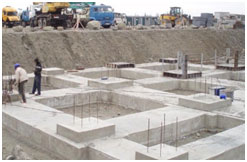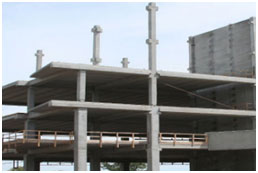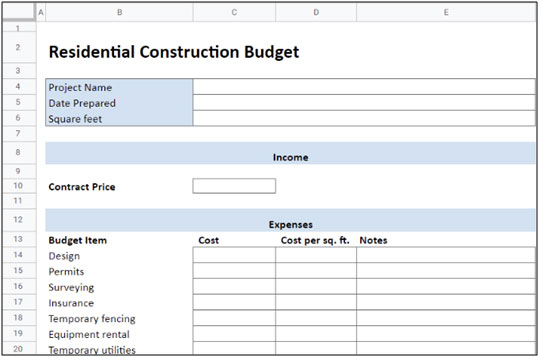
Steps in Construction of Residential Building

A series of routine tasks has been completed during the construction of a residential building. Lots of tedious work and time has been managed by the skilful workers to construct the residential building. The entire building's construction process has been divided into three phases which are preconstruction phase, construction phase, and post-construction phase.

Preconstruction phase
The client must have to work closely with the team and contractor before starting the residential building construction project. This phase has been done by following several steps which are:
Step 1: Initiation of the project
Proper planning and preparation are required while constructing the residential building. In this regard, a team of architects, contractors and engineers needs to be created.
Step 2: Soil testing of the construction site
Soil testing is one of the crucial steps while constructing a building which ensures the load-bearing capacity of the soil, the foundation moisture content and other important features which are required for ensuring the residential building quality. By testing the soil, builders can make a proper foundation without compromising the quality of the building construction process.

Step 3: Construction process design and specifications
In this step, builders can make plans and convert their plans into blueprints which contain elevations, floor plans and others. In this phase, workers can coordinate with the construction activities to achieve the project goal.
Step 4: Getting approvals from respective authorities
A licence from the local administration is necessary before starting the construction process. The owner of the residential building has to take their building plan to the local authorities for scrutiny and approval before starting the construction process. The respective authorities observe the safety measures and quality standards of the residential buildings.

Construction phase
Step 5: Preparing the construction site
This is the initial step of the construction phase which includes the site clearance procedure. In this step, the ground levelling is also done to provide stability to the building. A strong ground has been prepared along with future settlement concerns.
Step 6: Laying the building foundation
On the basis of the soil condition and load-bearing capacity of the soil, standard materials including concrete and reinforced steel are used to make a durable foundation to support the weight of the residential building structure.

Step 7: Laying beam and slabs
Beams and slabs are placed above the foundation of the building structure. This process can be done by constructing reinforced concrete beams which enables the load distribution of the building. The plinth slab helps to create the hard floor of the building which helps to prevent moisture penetration into the materials as well as maintain the structural stability of the buildings.

Step 8: Column and beam formation
Columns and beams are other important elements of the building. The column helps to transfer the loads from the roof and beams help to distribute the load throughout the surface body of the building.

Step 9: Doing brickwork
Laying brick and stones together helps to provide the vertical enclosure for a building which helps to provide stability and insulation characteristics to the building structure.

Step 10: Making Lintle and Roof
The lintle is the horizontal framing which helps to support the weight above the door. Framing is required along with tiles, metals or other materials to make the roofing system which enables the weather resistance properties of the residential buildings.

Step 11: Doing electrical and plumbing works
Running wires from the switchboards helps in proper power distribution throughout the building. In addition, plumbing work is also necessary for water supply and making proper drainage systems in the building.

Step 12: Doing flooring works
The installation of tiles, carpets and other materials depends upon the types of floors.

Post-construction phase
Step 13: Doing interior and exterior design
This type of construction work helps to make the building more attractive. This work can be done by creating a suitable theme for the building, applying versatile natural shades inside and outside the building, installing proper lighting fixtures inside and outside the house and decoring the entire building with indoor and outdoor furnitures.

Step 14: Applying paints
The selection of paints also plays an important role in making the aesthetic looks for the building and increasing the longevity of the building.

Step 15: Checking quality
The inspection of all construction works is necessary to meet the required building standards. In this regard, the creation of a complete checklist for each and every aspect of the building construction process, hiring experts to conduct inspection procedures and conducting regular inspections are crucial.
To learn more, watch the following video tutorial.
Video Source: Civil Engineering Pedia
Construction Spreadsheet
Construction Spreadsheets are a valuable tool for construction estimation. The numerical data regarding the construction process has been organised by Construction Spreadsheet which helps to interpret appropriate results. The numerical data of the construction process helps to determine the costs of the construction process and helps to estimate the profit margin of that construction process.

Key benefits of using Construction Spreadsheet
➢ A construction spreadsheet is a cost-effective and powerful tool used by construction estimators.
➢ Estimators used construction spreadsheets to rack the labour, material and overhead costs in the construction project.
➢ The changes in the data regarding the construction process have been tracked faster than the manual procedures, as a result, the over-budget estimates of that construction project have been identified correctly and quickly.
➢ Construction spreadsheet also enables the estimators to interpret accurate results of their analysis.
➢ The workflows and the parameters in the construction project can be adjusted quickly by the estimators with the help of a construction spreadsheet which helps the estimators to compare different types of costs of that construction project.
➢ Multiple copies of the important documents can be made for different situations with the use of a construction spreadsheet.
➢ The risk of costly mistakes has been minimized by using construction spreadsheets.


